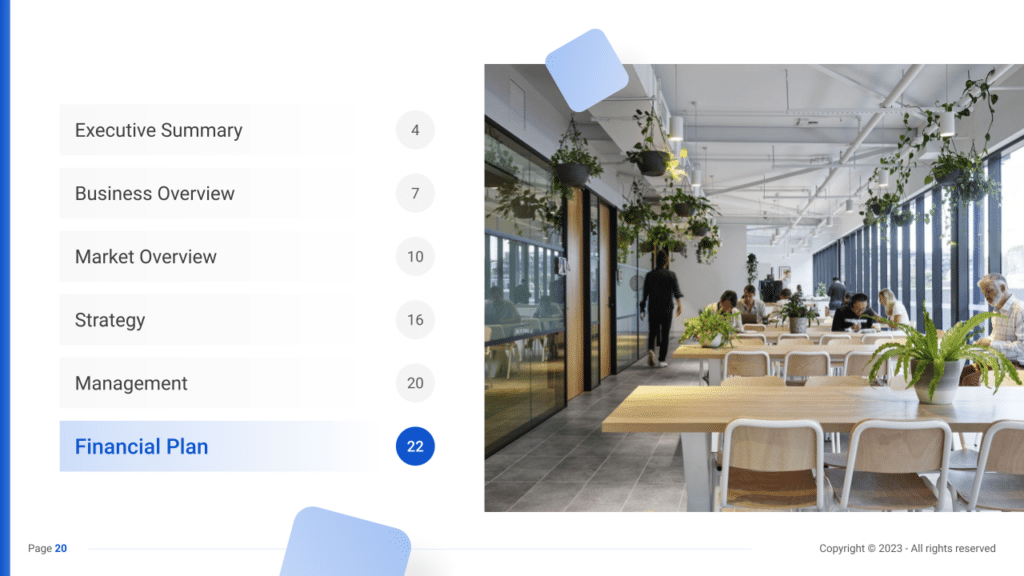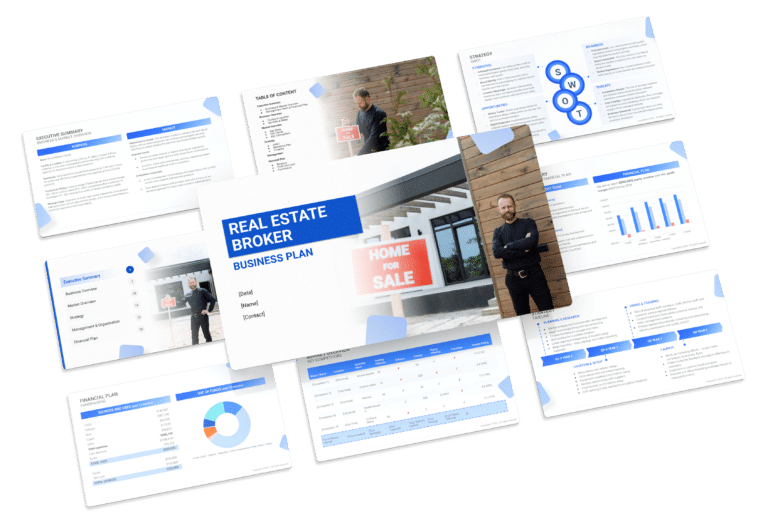Coworking Business Plan Template & PDF Example

Creating a comprehensive business plan is crucial for launching and running a successful coworking business. This plan serves as your roadmap, detailing your vision, operational strategies, and financial plan. It helps establish your coworking business’s identity, navigate the competitive market, and secure funding for growth.
This article not only breaks down the critical components of a coworking business plan but also provides an example of a business plan to help you craft your own.
Whether you’re an experienced entrepreneur or new to the real estate industry, this guide, complete with a business plan example, lays the groundwork for turning your coworking business concept into reality. Let’s dive in!
The Plan
Our coworking business plan is designed to encapsulate all key facets essential for a robust strategy. It includes detailed descriptions of the coworking space’s operations, marketing strategies, market context, competitors, leadership team, and financial expectations.
- Executive Summary: Summarizes the coworking space’s business idea, market evaluation, management organization, and financial plan.
- Business Overview: Provides comprehensive information on the coworking space’s features and operational blueprint:
- Facility & Location: Describes the physical layout, design, and strategic location of the coworking space.
- Services: Details the range of services offered, including various seating options, meeting rooms, and additional amenities.
- Market Overview: Investigates the coworking industry, spotlighting competitors and distinguishing factors of your space:
- Key Stats: Delivers statistics on the coworking market size, growth rates, and industry benchmarks.
- Key Trends: Identifies emerging trends influencing the coworking sector.
- Key Competitors: Compares major competitors, analyzing their offerings against yours.
- Differentiation: Explains how your coworking space stands apart from competitors.
- Strategy: Lays out the strategic plan for growth and member acquisition:
- SWOT Analysis: Evaluates strengths, weaknesses, opportunities, and threats.
- Marketing Plan: Develops strategies for marketing and member engagement.
- Timeline: Charts significant milestones and targets from inception through the first operational year.
- Management: Details the coworking space’s management structure and the roles of key team members.
- Financial Plan: Forecasts the financial trajectory over five years, highlighting revenue streams, profit margins, and anticipated expenses.

Executive Summary
The Executive Summary introduces your coworking space’s business plan, offering a concise overview of your coworking facility and the services it provides. It should outline your market positioning, the variety of workspace solutions and amenities you offer, its location, size, and a description of day-to-day operations.
This section should also discuss how your coworking space will integrate into the local market, including an assessment of the number of direct competitors within the area, identifying who they are, along with your space’s unique selling points that differentiate it from these competitors.
Moreover, you should include information about the management and co-founding team, detailing their roles and contributions to the coworking space’s success. Additionally, a summary of your financial projections, including revenue and profits over the next five years, should be presented here to provide a clear picture of your coworking space’s financial plan.
Coworking Business Plan Executive Summary Example
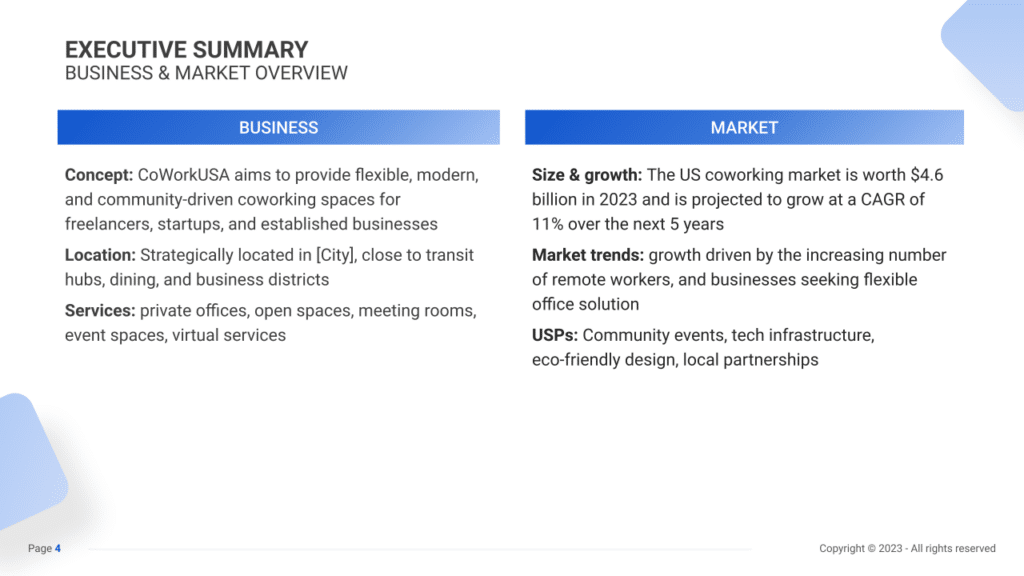
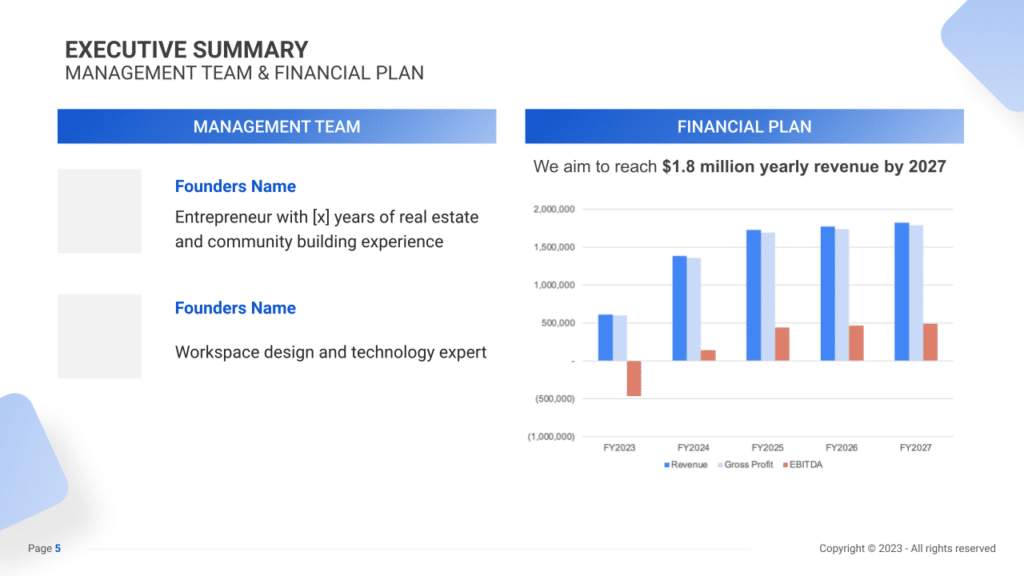
Business Overview
The business overview should succinctly define the key aspects of CoWorkUSA, including its range of services, such as private offices, open spaces, and meeting rooms. Highlighting the unique aspects that set CoWorkUSA apart, like its community events, tech infrastructure, and eco-friendly design, is crucial for drawing interest and investment.
Example:
CoWorkUSA, located in the heart of [City], offers a vibrant and innovative coworking environment. The space includes high-tech, eco-friendly designed private offices, open coworking areas, versatile meeting rooms, and event spaces. It also provides virtual services and fosters local partnerships, creating a dynamic and supportive community for its members.
Market Overview
This section should analyze the coworking market’s size, growth trends, and key industry developments. It positions CoWorkUSA within the industry and highlights its potential to meet the increasing demand for flexible workspaces.
Example:
CoWorkUSA enters a US coworking market worth $4.6 billion, expected to grow at an 11% CAGR. With market trends favoring remote work and flexible office solutions, CoWorkUSA is well-positioned to cater to a growing segment of mobile professionals and businesses looking for adaptable workspace solutions.
Management Team
Detailing the management team’s background and roles is essential. This part of the summary should emphasize their experience in real estate, workspace design, and community building, underscoring their capability to lead CoWorkUSA to success.
Example:
One co-founder of CoWorkUSA, an experienced entrepreneur with a background in real estate and community building, leads the strategic development of the space. The other co-founder, an expert in workspace design and technology, focuses on creating an innovative and efficient work environment.
Financial Plan
Clearly outlining the financial goals and projections is key. This section should include revenue targets and profit margins, offering insight into CoWorkUSA’s financial health and growth prospects.
Example:
CoWorkUSA aims to achieve $1.8 million in yearly revenue by 2027. Supported by a strategic approach to space management, community engagement, and marketing, the coworking space is positioned for significant growth in the expanding coworking market.
Business Overview
For a coworking business, the Business Overview can be succinctly outlined as follows:
Facility & Location
Detail the coworking space’s design and atmosphere, emphasizing a productive and collaborative environment. Highlight the location’s accessibility and nearby amenities, underlining the strategic advantage in attracting freelancers, startups, and remote workers.
Services & Pricing
Explain the variety of workspace options, including hot desks, private offices, and meeting rooms, along with amenities like high-speed internet and communal spaces. Present the pricing strategy, emphasizing value and market alignment, and mention flexible membership plans to foster community and loyalty.
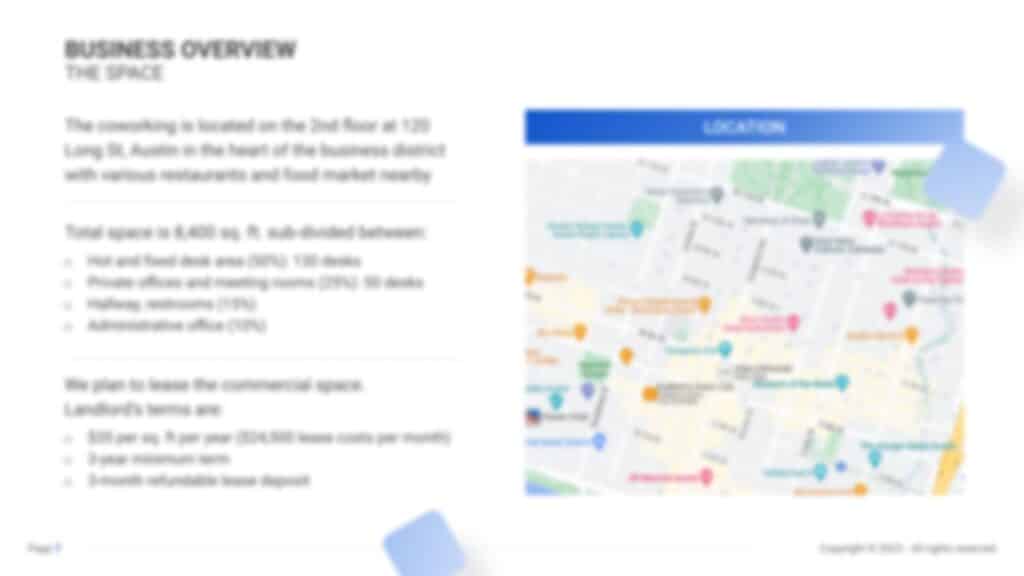

Market Overview
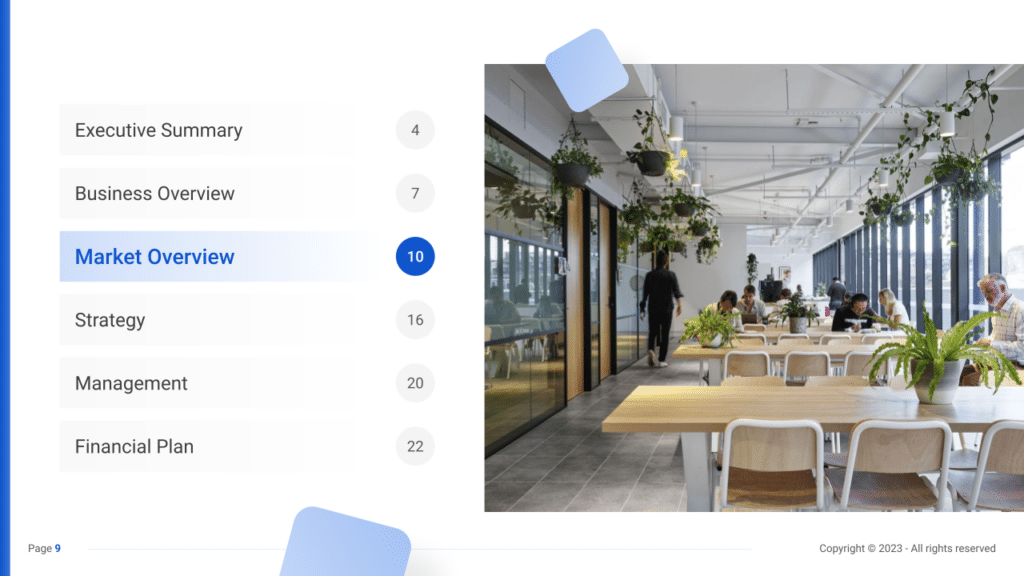
Industry Size & Growth
In the Market Overview of your coworking business plan, start by examining the size of the coworking space industry and its growth potential. This analysis is essential for understanding the market’s scope and pinpointing opportunities for expansion.
Key Market Trends
Continue by discussing recent market trends, such as the growing demand for flexible workspaces, the shift towards remote working, and the emphasis on community and networking opportunities within coworking spaces.Highlight the increasing preference for coworking spaces among freelancers, startups, and even large corporations looking for agility and innovation. Also, note the trend towards specialized coworking spaces catering to specific industries or professional needs, enhancing the value proposition for members.
Competitive Landscape
A competitive analysis is not just a tool for gauging the position of your coworking business in the market and its key competitors; it’s also a fundamental component of your business plan.
This analysis helps in identifying your coworking business’s unique selling points, which are essential for differentiating your business in a competitive market.
In addition, competitive analysis is integral in laying a solid foundation for your business plan. By examining various operational aspects of your competitors, you gain valuable information that ensures your business plan is robust, informed, and tailored to succeed in the current market environment.
Identifying Coworking Competitors
Begin by mapping out local and global coworking spaces. Identify direct competitors offering similar amenities and services, such as shared office spaces, meeting rooms, networking events, and specialized facilities like tech-equipped workstations or creative hubs.
Also, acknowledge indirect competitors such as traditional office spaces, home offices, or remote work setups, which might cater to your potential clientele. Leverage online platforms like Google Maps and coworking directories to gain insights into the geographical distribution and variety of coworking spaces.
Platforms like Coworker.com and Yelp not only provide listings but also offer valuable user reviews, highlighting the strengths and weaknesses of rival coworking spaces. For instance, positive reviews about the collaborative community and modern infrastructure at “Innovate Hub” signify a key strength of that particular competitor.

Coworking Competitors’ Strategies
Analyze the strategies employed by your competitors across various dimensions:
- Service Offerings: Assess the range of services and amenities provided. If a rival coworking space, “Tech Nexus CoLab,” is gaining traction for its high-speed internet and dedicated tech support, it reflects a trend toward tech-focused work environments.
- Space Design and Specialization: Consider the design ethos and specialization. A coworking space like “Creative Spark” might attract artists and designers with its vibrant, creatively themed interiors, while “Corporate Suites Inc.” might cater to professionals seeking a more corporate environment.
- Pricing Models: Compare pricing structures and membership plans. Are your rates similar to the budget-friendly options at “Economy CoWorks” or more aligned with premium offerings like “Executive Business Quarters”?
- Marketing and Branding: Study how competitors position and market themselves. Are they leveraging social media extensively, or do they rely on partnerships and industry events for brand exposure?
- Member Experience: Evaluate the member experience, such as the community vibe or additional perks. “CollabConnect” might excel at fostering a sense of belonging through regular networking events and member-exclusive workshops.
- Operational Efficiency: Observe if competitors are implementing innovative technologies for efficient space management, such as “SmartSpace Solutions” with its smart booking app and IoT-enabled workspace control.
What’s Your Coworking Service’s Value Proposition?
Define your unique value proposition within the coworking sphere. Perhaps your coworking space specializes in fostering niche communities like tech startups or social enterprises, or you might offer specialized facilities like podcasting studios or wellness areas that cater to specific professional needs.
Identify market gaps through member feedback and industry trends. For example, the rising demand for hybrid workspaces that blend physical and virtual experiences might represent an opportunity if competitors haven’t capitalized on this trend.
Consider your location and target audience preferences: A downtown coworking space might emphasize modern amenities and connectivity for professionals seeking convenience, whereas a suburban setting could focus on a serene environment and family-friendly workspace solutions.
Strategy

SWOT
First, conduct a SWOT analysis for the coworking business, highlighting Strengths (such as diverse workspace options and a strong community network), Weaknesses (including potential high overhead costs or market saturation), Opportunities (for example, the growing trend of remote work and the gig economy), and Threats (such as economic downturns that may reduce demand for office spaces).
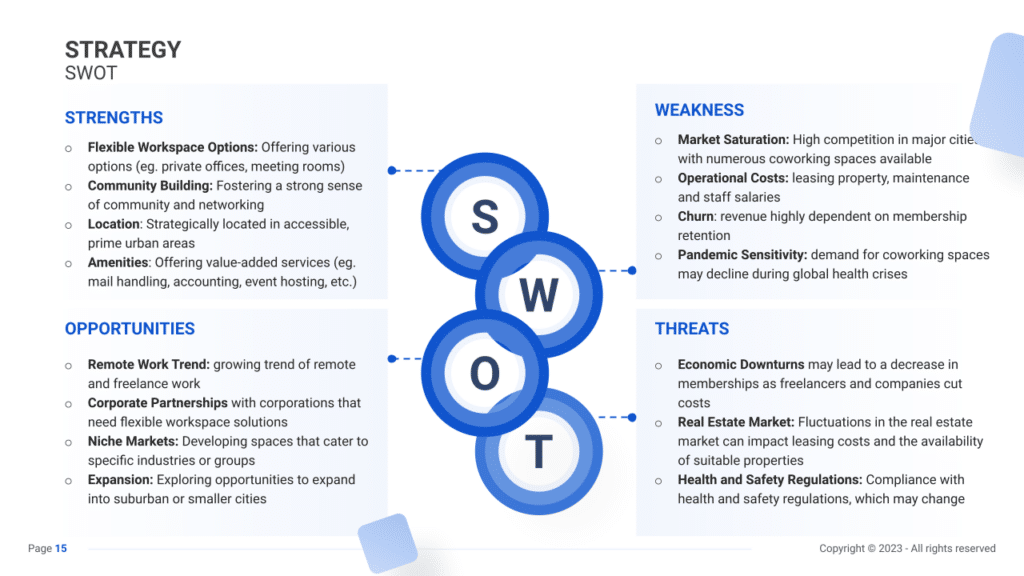
Marketing Plan
Next, develop a marketing strategy that outlines how to attract and retain members through targeted advertising, flexible membership plans, a strong online presence, and networking events. Emphasize the importance of building a community and the value of added services and amenities to differentiate your coworking space from competitors.
Marketing Channels
Selecting the right marketing channels enables effective communication of your brand’s message and services to potential members, fostering brand awareness and engagement.
Digital Marketing
Establish a robust online presence:
- Social Media Platforms: Utilize platforms like LinkedIn, Twitter, and Instagram to showcase your space, share member success stories, and promote community events. Engage with the audience through relevant content and interactive posts.
- Website and SEO: Expand on the components of your website, emphasizing ease of navigation, compelling visuals, detailed membership plans, and a blog section offering valuable industry insights or workspace productivity tips. Detail SEO strategies including keyword research, content optimization, and local SEO tactics to boost your space’s visibility in search engine results pages (SERPs).
- Content Marketing: Create blog posts, e-books, or videos offering insights into workspace productivity, industry trends, or entrepreneurial tips, positioning your space as a knowledge hub.
Local Outreach
Forge connections within the local community:
- Networking Events: Host or sponsor networking events, workshops, or seminars catering to local professionals or entrepreneurs. Establish your space as a go-to venue for such gatherings.
- Partnerships: Collaborate with local businesses, startup incubators, or educational institutions for mutually beneficial partnerships or referral programs.
Physical Marketing
Utilize offline channels:
- Brochures and Flyers: Design eye-catching print materials to distribute in business districts, cafes, or industry-specific events.
- Local Advertising: Invest in local newspaper ads or radio spots to target a broader audience within your vicinity.
Promotional Activities
Entice potential members with compelling offers:
- Free Trial Days: Offer a day or week of complimentary workspace access to allow prospective members to experience your facilities.
- Referral Programs: Incentivize existing members to refer new members by offering discounts on membership fees or additional perks.
- Events and Workshops: Host events or workshops relevant to your target audience, showcasing your space’s amenities, and fostering networking opportunities.

Sales Channels
Efficient sales channels facilitate seamless membership acquisition and retention strategies.
Consultative Selling
Personalized approach to membership sales:
- Tailored Solutions: Understand the unique needs of potential members and tailor membership plans or services accordingly.
- Trial Memberships: Elaborate on the structure and benefits of trial memberships offered by your coworking space. Detail the duration, access to amenities, and any additional perks during the trial period. Emphasize the objective of the trial memberships to give potential members a firsthand experience of the workspace, fostering trust and confidence in their decision to commit.
Online Booking and Sales
Streamline membership acquisition:
- User-Friendly Booking: Implement an intuitive online booking system allowing prospective members to explore available plans, and amenities, and book tours or memberships seamlessly.
- E-Commerce Integration: Allow online membership purchases and upgrades, making the signup process convenient for interested parties.
Membership and Retention Programs
Encourage member loyalty and retention:
- Membership Tiers: Create membership tiers with varying benefits, catering to different professional needs and budgets.
- Loyalty Rewards: Develop a rewards program where members earn points for engagement or referrals, redeemable for discounts or exclusive services.
- Networking Opportunities: Facilitate networking sessions, mentorship programs, or industry-specific events to foster a strong community within the coworking space.
Strategy Timeline
Finally, create a detailed timeline that outlines critical milestones for the coworking space’s launch, marketing initiatives, member acquisition, and potential expansion plans, ensuring the business progresses with clear direction and purpose.

Management
The Management section focuses on the coworking business’s management and their direct roles in daily operations and strategic direction. This part is crucial for understanding who is responsible for making key decisions and driving the coworking business toward its financial and operational goals.
For your coworking business plan, list the core team members, their specific responsibilities, and how their expertise supports the business.
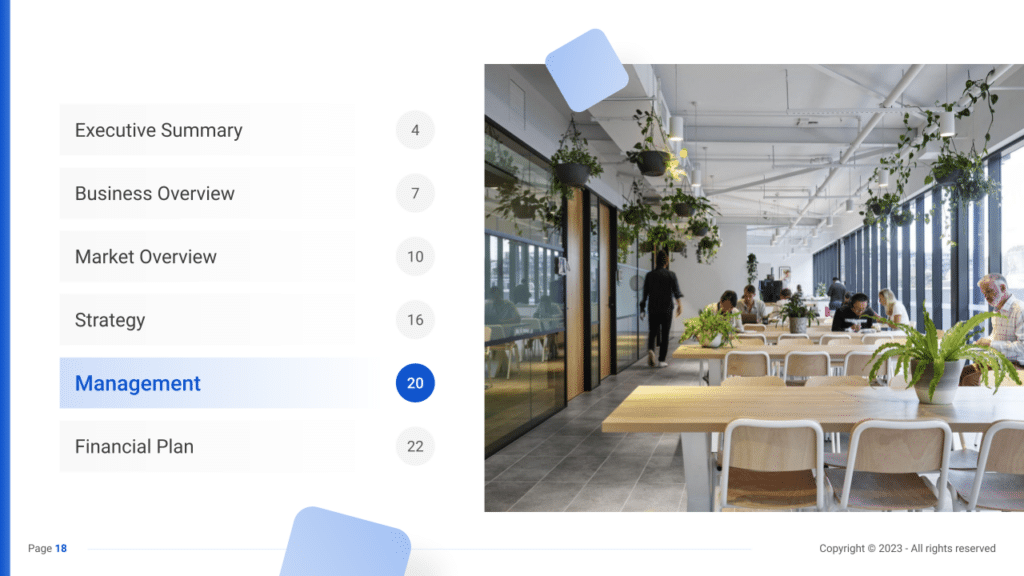

Financial Plan
The Financial Plan section is a comprehensive analysis of your financial projections for revenue, expenses, and profitability. It lays out your coworking business’s approach to securing funding, managing cash flow, and achieving breakeven.
This section typically includes detailed forecasts for the first 5 years of operation, highlighting expected revenue, operating costs, and capital expenditures.
For your coworking business plan, provide a snapshot of your financial statement (profit and loss, balance sheet, cash flow statement), as well as your key assumptions (e.g. number of customers and prices, expenses, etc.).
Make sure to cover here
_ Profit and Loss
_ Cash Flow Statement
_ Balance Sheet
_ Use of Funds
